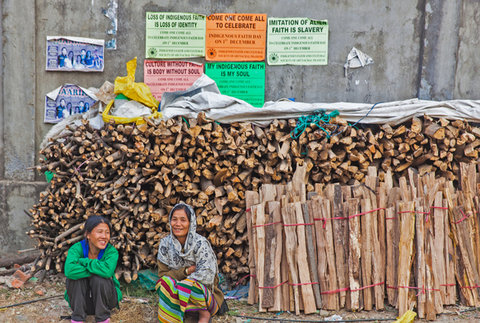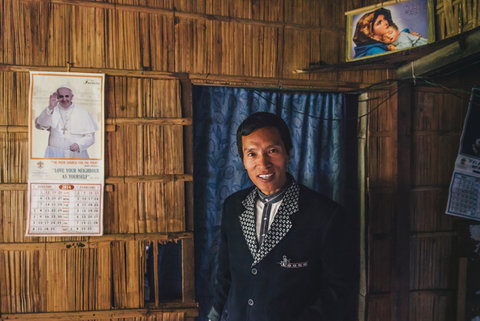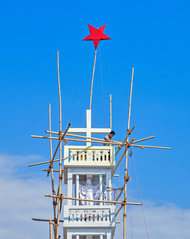Arunachal Pradesh : Christianity growing briskly in the state
February 15, 2014
Magha Krushnapaksha 1, Kaliyug Varsha 5115
 |
Itanagar (Arunachal Pradesh) : Though the event they advertised had passed a month earlier, the neon-colored posters remained, clinging to the state capital’s walls, lampposts and storefronts. On them were invitations to Indigenous Faith Day celebrations on Dec. 1, with slogans like “Culture without faith is body without soul,” and, more pointedly, “Imitation of alien faith is slavery.”
Implicit in the slogans for the event, which began in 2011, is the idea that this northeastern state, populated mostly by tribal people, is being stripped of its distinctive religious identity as hundreds of thousands have converted to Christianity.
Most outsiders hear about this remote Himalayan state in the context of tensions with China over repeated border incursions and blueprints to build hundreds of dams on its icy, blue rivers. But most Arunachal Pradesh residents are more concerned with adapting to a society increasingly drawn along religious rather than tribal lines.
 |
In Itanagar’s residential neighborhoods, most households identify themselves with religious markers — a star lantern for Christians, and a white flag with a red sun, for animists. “We’re at a junction where we are dichotomizing,” said Toku Tayu Stephen, the catechist at St. Joseph’s Cathedral in Itanagar.
Hundreds of thousands in this mountainous and sparsely populated state have converted to Christianity in recent years, and the trend has accelerated exponentially over the past four decades. The 1971 census showed less than 1 percent of Arunachal Pradesh’s residents called themselves Christian, but in 2001, 19 percent of the state’s total population and 26 percent of the tribal population put themselves in that category.
While religious data for the 2011 census hasn’t been released yet, many observers say that it is likely that Christians now form a majority of the approximately 1.4 million people in the state, with some tribes almost fully converted.
Less than a decade ago, Arunachal Pradesh was the only state in India to have a majority population adhering to tribal religions. Tribes in other northeast Indian states like the now-solidly Christian Mizoram, Meghalaya and Nagaland converted much earlier, while Hinduism dominates the plains of Assam.
 |
Women attending mass at St. Joseph's Cathedral in Itanagar, Arunachal Pradesh, on Dec. 23, 2013.Himanshu Khagta Women attending mass at St. Joseph’s Cathedral in Itanagar, Arunachal Pradesh, on Dec. 23, 2013.
Anthropologists like Stuart Blackburn, who have chronicled social change in Arunachal’s tribes, contend that Christianity’s infiltration into Arunachal Pradesh began slowly, mostly through locals who descended into the Assamese plains to be educated in well-regarded missionary schools there, only to return with a new religious zeal, as well as English-language skills and new names like John and James.
In the 1980s and earlier, barely any convents or Christian institutions existed in Arunachal as missionary work was, as it still is, outlawed under the Freedom of Indigenous Faith Act of 1978. These days, in spite of the law, Christian schools, hospitals and churches abound, particularly in central Arunachal, where the state’s most populous and powerful tribe, the Nyishis, live.
The state’s chief minister, Nabam Tuki, who is both a Nyishi and a Christian, donated some of the funds used to build St. Joseph’s Cathedral where Mr. Stephen, 41, has been a catechist for two years.
“1978 didn’t matter,” said Mr. Stephen, who was the son of an animist priest but converted at a convent school in Assam as a boy. “Our first concern was to come back home and heal people. So much disease was there in our villages. We showed people that God could send miracles, and many people wanted to convert right away.”
But there were other reasons to convert – some practical, like the need for better education and healthcare, which churches promised to bring, and others more spiritual. “Our people are religious by nature,” said Mr. Stephen. “We’ve always believed in a supreme being who will smite you if you sin, and we’ve always had a mother figure like Mary.”
Mr. Stephen said that people, especially in rural areas, are still coming around to “the truth,” and that Christianity was largely a unifying force in a state that has dozens of tribes whom often fought each other.
He said that during Christmas and Easter seasons, pastors from cities like Itanagar visited villages where residents had been waiting for months to be officially converted, and performed mass baptisms. “People are just waiting,” he said, “especially to be freed from sickness.”
Toku Tayu Stephen, catechist at St. Joesph's Cathedral, at his home in Itanagar in December 2013.Himanshu Khagta Toku Tayu Stephen, catechist at St. Joesph’s Cathedral, at his home in Itanagar in December 2013.
Nani Bath, a professor of political science at Rajiv Gandhi University near Itanagar, said many tribals converted out of a desire to be modern, since Christianity was often seen in the same boat as modernity.
“See, at these churches, you’d have guys playing guitar and pretty girls singing in English, and no one was allowed to drink, which was very rampant both then and now in this state,” he said.
Lisa Lomdak, a linguist and colleague of Professor Bath’s, said that for those with a 21st-century mindset, the traditional wedding practice of slaughtering dozens of mithuns, a type of mountain bovine, was disagreeable.
For others, she said, the ritual slaughter was just too expensive, and converting to Christianity was one way to save money.
Professor Lomdak, herself a follower of the Donyi-Polo faith, an organized form of animism that translates as “sun-moon,” lamented that conversions are part of a larger erosion of tribal culture and endangerment of local language.
St. Joseph's Cathedral in Itanagar, Arunachal Pradesh, undergoing renovation.Himanshu Khagta St. Joseph’s Cathedral in Itanagar, Arunachal Pradesh, undergoing renovation.
St. Joseph's Cathedral in Itanagar, Arunachal Pradesh, undergoing renovation.Himanshu Khagta St. Joseph’s Cathedral in Itanagar, Arunachal Pradesh, undergoing renovation.
“Even if our kids speak our language, they aren’t fluent,” she said. “They aren’t even competent. Wherever there is dish TV, you’ll see kids excelling in English and Hindi. And when kids sing old tribal songs, other kids tell them to stop because ‘those are not Jesus songs.’”
Tribal religion has adapted some of the modern forms of worship in response to its dwindling followers. Within the past five years, locals say, the Donyi-Polo faith has become more institutionalized in its practices, as its leaders have realized that it suffers from being seen as a disorganized and timeworn default religion.
 |
From its age-old pantheon, the cosmic duo of Donyi and Polo have been promoted as the primary gods, while previously absent elements like prayer halls, designated holidays, chant books, the use of incense and ringing bells and the visual depiction of gods and goddesses have been introduced.
To many, these spiritual building blocks are eerily reminiscent of Hinduism’s. Professor Bath said right-wing Hindu organizations like the Rashtriya Swayamsevak Sangh, or R.S.S., finance Donyi-Polo schools and cultural centers, promoting it as a unified Arunachali religion. The R.S.S. is aligned politically with the Bharatiya Janata Party, which has lost ground in a state where Christians have gained increasing power through the Congress Party.
Last month, Mohan Bhagwat, the chief of R.S.S., traveled to Pasighat, in the eastern part of the state, to address 600 members of his organization at the Donyi-Polo Vidya Niketan, one of the schools funded by the Hindu nationalist organization. At numerous R.S.S.-sponsored events, the life of Talom Rukbo, the father of modern, institutionalized Donyi-Poloism, has been memorialized.
Professor Lomdak said some Hindus may see tribal animist faiths simply as a substratum of their own. She acknowledged that the borders between her religion and Hinduism were blurry. All the same, she worried that Christianity, and not Hinduism, would prove most corrosive to her state’s indigenous culture.
Mr. Stephen, having just left a Mass given in the Nyishi language, presented a different take on the transformation. “Before criticizing, they should really ask themselves how ‘alien’ Christianity really is,” he said. “Already, in the towns and also the villages, this religion is becoming our tradition.”
Source : India INK
No comments:
Post a Comment